How River Guides Use Twitching Jigs For Steelhead
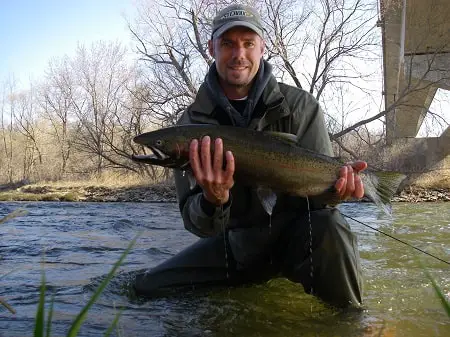
Although river guides around the Great Lakes and West Coast are twitching jigs for steelhead to put their clients onto a lot of steelhead, I still rarely see other anglers using jigs this way.
I’ve had the opportunity to learn a lot about twitching jigs for steelhead from West Coast and Great Lakes river guides.
Twitching jigs for steelhead means you are casting and retrieving large twitching jigs using an up-and-down twitching and swimming type of retrieve. You raise and lower your rod tip in a “w” type motion to get the jig to follow the same “w” type pattern.
Twitching jigs for steelhead successfully requires proper presentation, The right rod and reel, and the best types of twitching jigs of the right colors and sizes.
The Reason And Method For Twitching Jigs For Steelhead
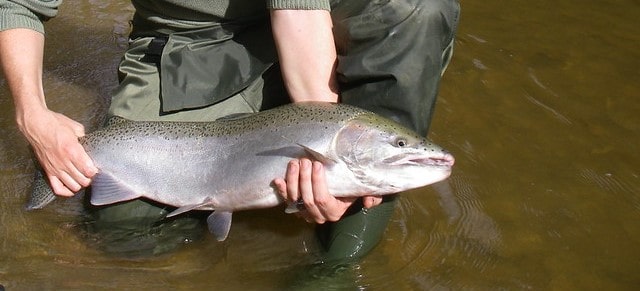
The reason why twitching jigs for steelhead work so well is that the erratic motion and swim pattern of the jig. This erratic swim pattern replicates an injured baitfish.
In the animal kingdom, it’s usually the young, old, dying, or injured that get eaten and killed by predatory animals, and steelhead are predators.
I have seen firsthand (probably hundreds of times), the difference between how often a straight-moving lure gets grabbed, compared to the same lure twitched or erratic-moving.
Just watch professional bass anglers work a minnow-type bait like a Rapala. While a new angler will cast and then straight retrieve a Rapala lure, a pro will almost always twitch and rip the lure and impart some extra action almost all the time, and the difference is often 10 times more fish for the pros.
When twitching jigs for steelhead, you are working the jig in an erratic motion that resembles and struggling baitfish, and it’s hard for a predatory fish not to want to grab it. That erratic action triggers a predatory strike response.
The more a lure or a jig looks like an injured struggling baitfish, the more those predator fish will want to crush it. And a twitched jig is a great lure for this!
To twitch jigs properly, you simply move your rod tip from your knees or waist to just over your head, or to a 45-degree angle, and then drop down again while taking up the slack line.
This up-and-down rod tip motion causes the jig to swim in an almost “W” type pattern. A steady up-and-down speed often works best.
GUIDE TIP: Going too fast up and down can make the jig jump around too fast and too erratic, and the fish might try to hit it, but they will miss it too often. Going fast up, and going slower down, and maintaining a steady pattern will get you more hookups.
Also, dropping the rod too fast puts slack in the line, and if you get a bite when there is slack in the line, you won’t feel it, and this gives the fish a chance to let go.
Also, try to keep your pulls shorter! You don’t want the jig jumping 6 feet up and dropping 6 feet down. This might be too far for the fish to chase it up and down, and they will give up.
Moving the jig up and down 2 to 3 feet is great. Even one-foot jumps can be good, as long as the jig looks like it’s a wounded, struggling, or dying baitfish you are good.
While most anglers like to lift up and drop their tip at the same speed, I think there is a better way to get more hook-ups.
I like to lift on a steady and fairly quick lift up, and then a slow lowering of the rod while trying to maintain slight tension all the way down is better. As you lower the rod tip, you reel fast enough to keep the slack out of the line. Doing it this way makes the jig lift quickly at about a 45-degree angle, but it descends slower and on a lesser 25 to 35-degree angle.
Once I started doing this, I was amazed at how many fish would hit as the lure was descending. It made me wonder how many fish I had missed in the past.
How High, Or Low Should You Fish Your Jigs
I’ve already mentioned how far up to lift your jig and how far down to drop it, so this is about how deep or where in the water column do you want to fish your jig.
When the jig hits the water, if it’s deep water, (7 feet or deeper) you should let the jig sink to the bottom before you start your retrieve.
I know some of you will disagree but let me explain below.
If it’s shallower water, say 7 feet or less, you should start your retrieve as soon as it hits the water to keep the jig 1 to 4 feet over the steelheads head.
Since most steelhead and salmon will be within 20 inches off the bottom at all times, this means it’s best to keep your jig off the bottom by about 2 to 5 feet, and you should only be bumping the bottom now and then.
If you are not hitting the bottom and not catching fish, The spot you are fishing might be too deep and your jig may be too high out of the strike zone, and therefore, you may not catch any steelhead.
Now some anglers will disagree with me about letting the jig hit the bottom, but the bottom is not always the same depth, some areas will be shallow, while there may be a deep spot you are not aware of.
I also believe it’s better to be too close to the steelhead than to be too far from them.
Fish The Holes And Trenches
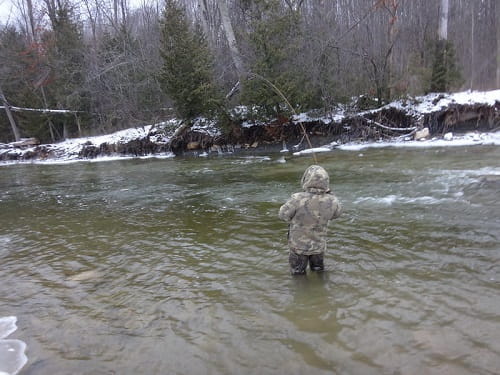
On a river that is 60 feet across, 60 percent of that section could be 5 feet deep, but there could be trenches or holes that are 10 to 15 feet wide and 5 to 10 feet deeper than the rest of the spot.
Often, steelhead will seek out these deeper sections and stack up in them; therefore, if you never let your jig sink to the bottom and you fish your jig high all the time, you will miss these deep fish because your jig might be way out of their strike zone.
I discuss these wholes and trenches when float fishing, bottom bouncing, fishing with nymphs, and now when twitching jigs for steelhead because I know there are spots on my home rivers where I know where these holes are, and I know that if I don’t drop my clients bait or jig another 4 to 6 feet deep, they’ll miss all the fish.
I’ve had clients make ten passes over a spot with zero results, as soon as I drop the bait or lure down 3 to 5 feet, they catch a lot of fish. I think this is where a lot of anglers make a mistake.
In fact, I teach my clients when they get to a new spot they are unfamiliar with, that their first goal is to find the bottom, once they find the bottom, then they can focus on fishing.
Twenty years of guiding has taught me that getting your bait or lure 3 to 5 feet off the bottom is critical if you want to catch the most fish possible.
And, I know that there are certain times of the year and times of the day when the fish will hold on the bottom in these holes. See my Winter fishing For Steelhead for more on this, but it’s not just due to cold water.
Steelhead will drop into the deepest sections due to the high bright sun, as well as when they are being heavily pressured by anglers, or when they are lethargic and cold.
When steelhead are pressured, cold, or staying out of the bright light, they often won’t move far for a bait or a lure, and therefore you need to get your jigs down and closer to the fish if you want them to bite.
On the flip side, if your jig is hitting the bottom too often, you should change your jig head and go with a lighter jig, or raise your rod tip higher to try to keep the jig higher in the water column.
GUIDE TIP: Letting your jig sink and hit the bottom is the only sure way to know you are deep enough. Once the jig hits the bottom, make two quick upward pulls to get the jig up and off the bottom, and then start your up-down jigging pattern. Doing this will get you jig 3 to 5 feet off the bottom.
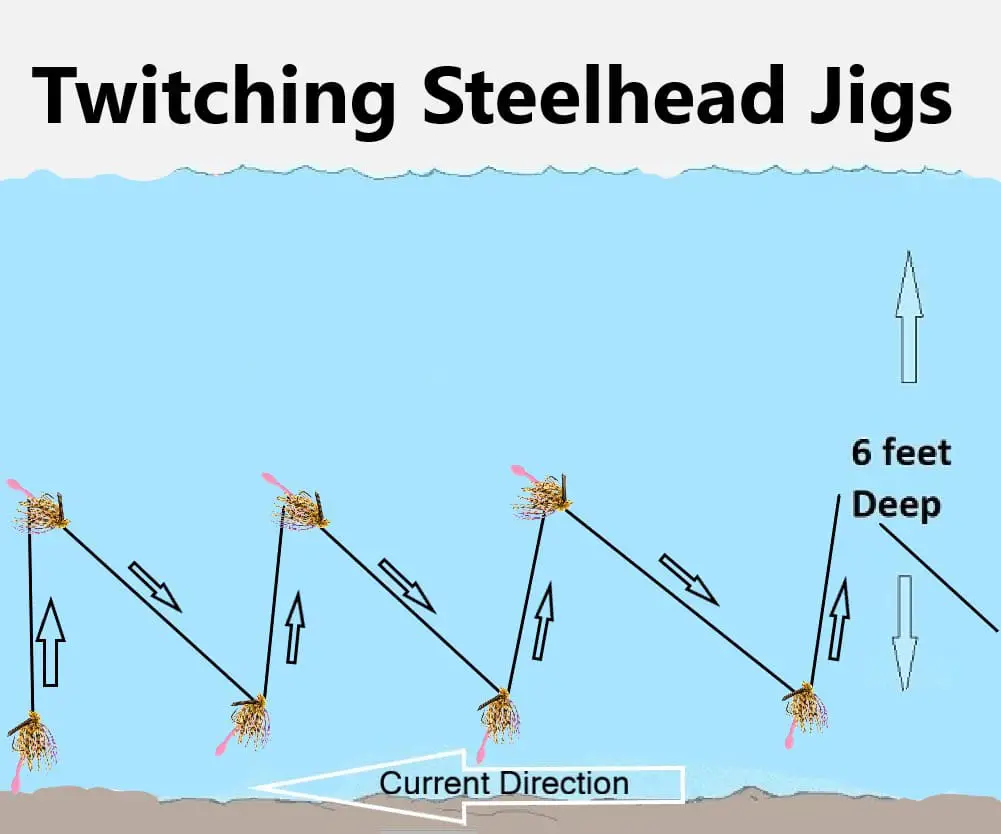
Best Steelhead Twitching Jigs
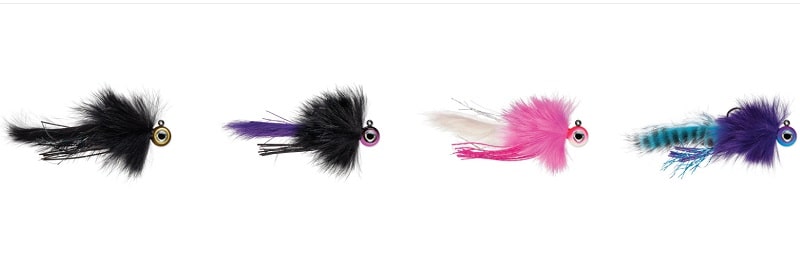
The best steelhead twitching jigs are ones with a lot of bulk or body to them and are made with bucktail hair, marabou, silicon or rubber skirts, or a combination.
You also want a larger, high-quality hook with a wide gap and a hook that is super sharp. Some of the cheaper jigs have a small gap and don’t hook or hold as well as jigs with a wide gap. Cheap jigs are also prone to bend or break and are not suitable for steelhead.
You will be bouncing your jig off the rocks, so a jig with a good finish that chips less is better.
My favorite steelhead twitching jig is the VMC Twitching Jig, but I also like the Northland Buck-A-Roo Jig, and the SPRO Bucktail Jig.
Best Twitching Jigs
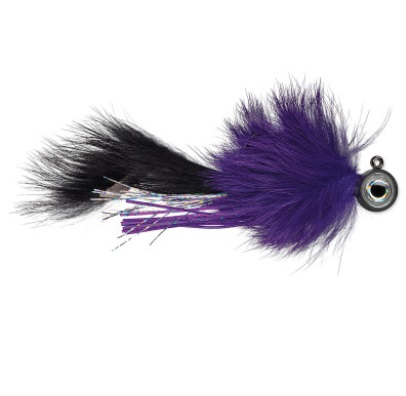
VMC Twitching Jig
There is a lot to like about this twitching jig which is why it’s my favorite.
- Big Eyes
- Sharp wide gap hook
- Rabbit hair and rabbit strip for body thickness, length, and life-like movement.
- Tinsel fibers, flashabou, and living silicone accents
- Lots of great colors
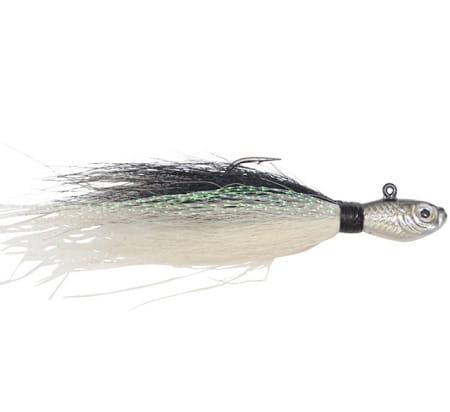
SPRO Bucktail Jig
Another great jig that is one of my favorite twitching jigs for both river and shore.
- made from bucktail for action, body, and length
- Sharp hook with a decent gap
- Lots of great colors and sizes
- Added flash
- Swim head and eye for unique swim action.
- Durable
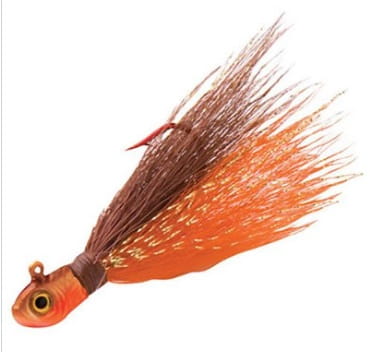
Northland Buck-A-Roo Jig
A twitching jig that is good for steelhead, trout, and salmon fishing.
- Mustad Ultra-Point hooks
- Good thickness and length
- Bucktail with flash for added attraction
- Lots of colors and sizes to choose from
- Large swim head with eyes
- Tip it with a twister tail or paddle tail
Best Size and Weights
When it comes to the size of the twitching jig you use for steelhead, you need to consider the overall size, which includes the length and girth, and the weight of the jig.
The best size Twitching jig for steelhead is 3″ to 4 inches long. However, I have caught many steelhead on 4.5″ and 5.5″ twitching jigs. In some cases, like when the water is low and clear, or if the steelhead are nervous due to being pressured, a smaller 2″ to 2.5″ jig can work well.
I also prefer a full-bodied jig versus and skinny-bodied jig. Skinny-bodied jigs will sink faster, but I have found a full-bodied jig looks better in the water and the fish seem to like them more.
For casting and twitching jigs, you want to match the weight of the jig to the depth and velocity of the spot you are fishing. This means for slow water; you are going to want to use a smaller 1/4-ounce jig head.
For faster, deeper water, you will likely need to upsize to 3/8, 1/2, 3/4, or even up to 1 ounce if the water is very fast and deep.
- Slow Water and Shallower water: 1/4 oz
- Medium speed and depth 5 to 12 feet: 3/8oz to 1/2oz
- Fast water, or fast and deep water 12 feet or deeper: 3/4oz to 1oz
If the water is deep, say 20 to 30 feet, but it’s very slow, I still prefer a 1/4 or 3/8oz jig head.
- 3/8-1/2 oz: Water depth of 5-10 feet
- 3/4-1 oz: Deep water and holes and/or strong flows
Adding Jig Tails
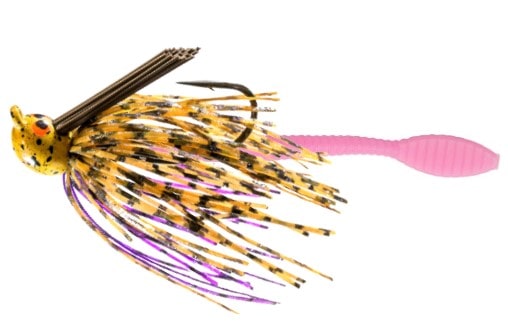
Adding a tail like A Mad River Paddle Tail Worm, a paddle tail minnow, or a twister tail is recommended because these tails can add more length and girth, and especially more eye-attracting movement to any jig.
Some of my favorite jig tails include:
- SPRO Pocket Tail Paddle Tail Minnows – See It Here
- Spro Wave tail Twister Grub – See It Here
- S-Pro Soft PaddleTail Minnow – See It Here
- Mister Twister Curly Tail Grubs – See It Here

Jig Colors
There are so many colors and color combinations that will work when twitching jigs for steelhead, but there are some rules I like to follow and teach my clients.
The first rule is to start with a natural color jig in lower or clear waters. Save the big ugly chartreuse, reds, oranges, and hot pinks for last.
If the water is dirty, start with those bigger gaudy bright flies that you probably think shouldn’t work. This dirty, off-colored, or high water is where your chartreuse, reds, oranges, hot pinks, or a combination of these colors will actually be good.
GUIDE TIP: I have found that the steelhead that have just entered the lower river will be more aggressive and will be accustomed to eating silver, shiny, and white colored baits; therefore, for fresh run steelhead in the lower river, white jigs with silver flash can be hot.
Hot and flashy jigs can also be good in the lower river with these aggressive steelhead.
As the steelhead move up the river and the longer they stay in the river, or as they become pressured or insecure due to lower clearer water, they will often prefer darker, more natural, and subtle colors like olive, black, and tan, and they might prefer jigs with less flash and color.
However, sometimes, when what you or I think should work but doesn’t work, if it’s not working, don’t be afraid to throw some crazy colors at them to see how they react.
Equipment For Twitching Jigs
Spinning Reels Suitable For Twitching Jigs For Steelhead: You can use spinning reels or baitcasting reels for jig fishing. The same reel you use for lures or when bait fishing will work.
Spinning reels should be size 30 to 40 and have a good drag, and hold enough line. I discuss the best spinning reels on my page, Best Spinning Reels For Steelhead.
Jig Rods For Twitching Jigs For Steelhead: Your rod doesn’t need to be a rod specific to jigging, however jig rods designed for bass and walleye might work, providing they have enough backbone to handle steelhead and are long enough.
I use and recommend 7’6″ to 8′ rods in the medium to medium heavy range, and I prefer fast action rods with a fast sensitive tip.
Save your soft shorter rods for bass or walleye.
Longer rods will help you keep your line off the shallow rocks should your big steelhead bolt down the river through the rapids.
And since you are on the bank and casting far out into sometimes 5 or 6 feet of water, the longer rod gives you extra height to help keep your jig higher and off the bottom.
My favorite rod for twitching jigs for steelhead, or for casting lures for steelhead is the G. Loomis IMX Twitch Spinning Rod, which is a rod that is actually designed for twitching jigs for salmon and steelhead in rivers. Check Price
Other Suitable rods are:
- Okuma SST New Generation Spinning Rod: 7’6 Medium Heavy -MODEL: SST-S-763MHA, or the 8 foot Medium Heavy – MODEL: SST-S-802MHA – Check Price
- St. Croix Premier Spinning Rods: The 7’6 Medium power is a great choice for jig and lure fishing for steelhead. Check Price
What Direction To Cast And Retrieve?
Watching anglers try to cover a pool drives me crazy sometimes. I tend to catch a lot more fish than most anglers, and I don’t mean to be bragging, but there are reasons for this.
One of the biggest reasons that I have been able to outfish most guys is simply because I am meticulous about how I cover the water! When I leave a spot, I want to be sure every fish in the spot sees my lure, jig, or bait.
For this reason, I pick apart every spot in a systematic and planned way.
One of the things I see that drive me crazy is anglers casting upriver and retrieving downriver towards the fish. This is a wasted cast in my opinion. How often do you think a baitfish is going to swim directly at the fish that wants to eat them?
The other thing is that predatory fish almost always attack their prey from the side or from below. Almost never do the attack head-on. So if you bring your lure head-on toward a steelhead, they will likely move out of the way or be spooked.
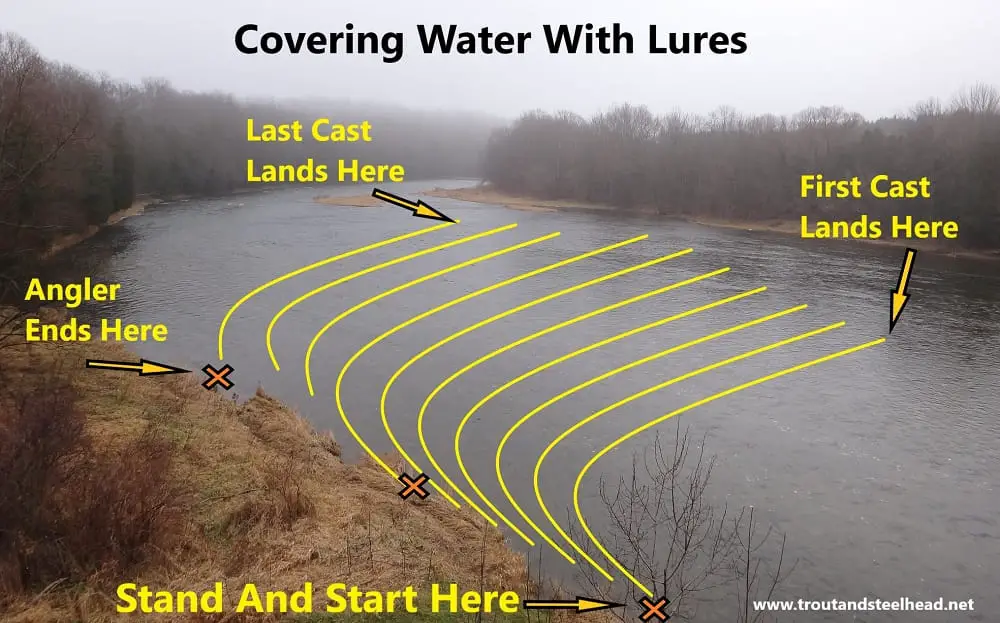
Therefore, I systematically fish every spot from the top of the spot to the bottom of the spot. I land each cast as far across as I can, or where the shallow water meets the deep water, and I drag the jig sideways across the river.
If I don’t get a bite, I move down 3 to 5 feet and repeat.
This slowly works your jig downriver at 3 to 5 feet increments and shows your jig to the fish at an easy-to-grab sideways angle.
Also, a sideway angle shows the largest profile of the jig to the fish, it also shows all the tail and body action from the feathers, hair, silicon, or tinsel, and it’s not a threat in any way to the fish, compared to a lure moving head-on at the steelhead.
Tight Lines,
Graham

Thanks for your million dollars article! I don’t usually find any information about using twitching jig for steelhead, this is the first one I found!!! Very good article and very detail information you provided. I am a big fan of twitching jig, most Coho I caught by twitching jig this year, I was surprised how good using twitching jig for Salmon!! Winter steelhead season is just around the corner , I have been wondering if I can catch steelhead using twitching jig? This million dollars article really answered my questions that I have been searching for a very long time!! Thank you very much. 👍🏻👍🏻👍🏻